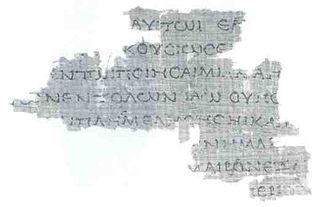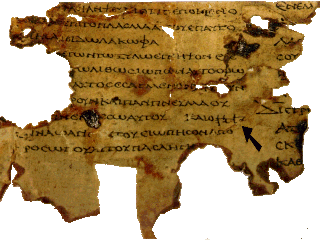
Solomon Schechter was a Moldavian-born American rabbi, academic scholar and educator, most famous for his roles as founder and President of the United Synagogue of America, President of the Jewish Theological Seminary of America, and architect of American Conservative Judaism.

The Cairo Geniza, alternatively spelled Genizah, is a collection of some 400,000 Jewish manuscript fragments and Fatimid administrative documents that were kept in the genizah or storeroom of the Ben Ezra Synagogue in Fustat or Old Cairo, Egypt. These manuscripts span the entire period of Middle-Eastern, North African, and Andalusian Jewish history between the 6th and 19th centuries CE, and comprise the largest and most diverse collection of medieval manuscripts in the world.

Hexapla is the term for a critical edition of the Hebrew Bible in six versions, four of them translated into Greek, preserved only in fragments. It was an immense and complex word-for-word comparison of the original Hebrew Scriptures with the Greek Septuagint translation and with other Greek translations. The term especially and generally applies to the edition of the Old Testament compiled by the theologian and scholar Origen, sometime before 240.
Aquilaof Sinope was a translator of the Hebrew Bible into Greek, a proselyte, and disciple of Rabbi Akiva.
In contrast to the variety of absolute or personal names of God in the Old Testament, the New Testament uses only two, according to the International Standard Bible Encyclopaedia.

The Tetragrammaton, or Tetragram, is the four-letter Hebrew theonym יהוה, the name of God in Judaism and Christianity. The four letters, written and read from right to left, are yodh, he, waw, and he. The name may be derived from a verb that means "to be", "to exist", "to cause to become", or "to come to pass". While there is no consensus about the structure and etymology of the name, the form Yahweh is now accepted almost universally.
Uncial 093, is a Greek uncial manuscript of the New Testament, dated palaeographically to the 6th century. Formerly it was designated by siglum ל.

Codex Marchalianus designated by siglum Q is a 6th-century Greek manuscript copy of the Greek version of the Hebrew Bible known as the Septuagint. The text was written on vellum in uncial letters. Palaeographically it has been assigned to the 6th century. Marginal annotations were later added to the copy of the Scripture text, the early ones being of importance for a study of the history of the Septuagint.

Papyrus Rylands 458 is a copy of the Pentateuch in a Greek version of the Hebrew Bible known as the Septuagint. It is a papyrus manuscript in roll form. The manuscript has been assigned palaeographically toward the middle of the 2nd century BC, and before the discovery of the Dead Sea Scrolls it was the oldest known manuscript of the Greek Bible. The manuscript has survived in a very fragmentary condition.

The Papyrus Fouad 266 are fragments, part of a papyrus manuscript in scroll form containing the Greek translation, known as the Septuagint, of the Pentateuch. They have been assigned palaeographically to the 1st century BCE. There is discussion about whether the text is original or a later recension of the Septuagint.

The manuscript 4Q120 is a Septuagint manuscript (LXX) of the biblical Book of Leviticus written on papyrus, found at Qumran. The Rahlfs-No. is 802. Palaoegraphycally it dates from the first century BCE. Currently the manuscript is housed in the Rockefeller Museum in Jerusalem.

The Greek Minor Prophets Scroll from Nahal Hever is a Greek manuscript of a revision of the Septuagint dated to the 1st century CE. The manuscript is kept in the Rockefeller Museum in Jerusalem. It was first published by Dominique Barthélemy in 1963. The Rahlfs-Siglum is 943.

The ms. Ambrosiano O 39 sup. – is a manuscript of the Hexapla of Origen dated to the late ninth century C.E. written in a codex form. This is a palimpsest. The manuscript is designated with the number 1098 in the list of the septuagint manuscripts as the classification of Alfred Rahlfs.
The Papyrus Vindobonensis Graecus 39777 signed as SymP.Vindob.G.39777 – is a fragment of a Greek manuscript of the Psalms of the translation of Symmachus. It was written in papyrus in a scroll form. The papyrus contains fragments of Psalm 69 and Psalm 81. The P.Vindob.G.39777 is dated to late third century or beginning fourth century.

The Papyrus LXX Oxyrhynchus 3522, – is a small fragment of the Greek Septuaginta (LXX) written in papyrus, in scroll form. As one of the manuscripts discovered at Oxyrhynchus it has been catalogued with the number 3522. Palaeographically it has been dated to the 1st century CE. The text agrees with the LXX.

Papyrus Oxyrhynchus 5101, designated P.Oxy.LXXVII 5101 contains fragments of a manuscript in Koine Greek of the Septuagint (LXX), written on papyrus in roll form. It has been palaeographycally dated to have been written between 50 and 150 C.E.

The AqBurkitt are fragments of a palimpsest containing a portion of the Books of Kings from Aquila's translation of the Hebrew bible from the 6th century, overwritten by some liturgical poems of Rabbi Yannai dating from the 9–11th century. This Aquila translation was performed approximately in the early or mid-second century C.E.

The siglum AqTaylor are fragments of a palimpsest containing a portion of the Palestinian Talmud in upper script, and part of the Book of Psalms of Aquila's Greek translation of the Hebrew Bible in lower script. This latter is a Greek biblical manuscript written in codex form. This manuscript has been dated after the middle of the fifth century C.E., but not later than the beginning of the sixth century C.E.

Papyrus 121 is a Greek magical manuscript written in papyrus from the 3rd century CE. This is one of that are called Greek Magical Papyri. The papyri had been brought from Egypt by Ernest Alfred Thompson Wallis Budge.
Taylor-Schechter 16.320 is a Greek biblical manuscript written on parchment in codex form. This is a palimpsest that contains the Palestinian Talmud and the Septuagint Psalms. The manuscript is dated 550 – 649 CE.















